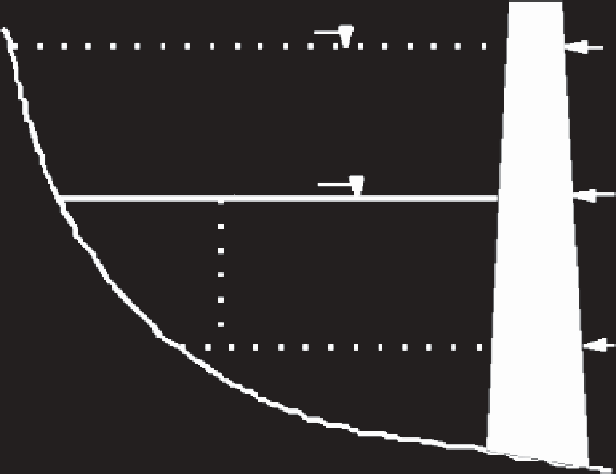Environmental Engineering Reference
In-Depth Information
case for the conservation pool is a buffer zone that contains storage (stored water) to be used to meet
essential demands in the event of a drought. The conservation pool includes usable storage, such as
for water supply, and hydropower. The lood control pool allows for the safe storage of water when its
release would cause lood damage downstream. If the reservoir does not have lood control storage,
this could be included in the conservation pool. Above the lood control storage is the surcharge zone
where the water level is above the emergency spillway but below the maximum dam height, above
which the dam would be overtopped. An example of the storage allocation for Everett Jordan Lake, a
U.S. Army Corps of Engineers multipurpose reservoir in North Carolina, is illustrated in Figure 10.4.
10.2.2 p
ooL
L
eVeL
c
ontroL
For reservoirs that have controlled releases, lake levels (i.e., storage) are varied to meet the reservoir
design purpose. For example, if the reservoir is designed for lood control, then one would want
the maximum available storage during the wet season, to accommodate or retain the lood. If the
reservoir is used for conservation purposes, the conservation pool, then one may want the maximum
storage during dry seasons.
For managed reservoirs, those with controlled releases, the design purpose (or purposes) is
typically incorporated into the management strategy in a reservoir operations manual, developed
when the reservoir is constructed. For federal facilities, those authorized by Congress, the water
management strategy is based on the speciic provisions of project-authorizing legislation as well
as water management criteria deined during the project planning and all applicable laws and
regulations (e.g., the Fish and Wildlife Coordination Act, the Federal Water Project Regulation
Act—Uniform Policies, the National Environmental Policy Act, and the Clean Water Act) as
described in the USACE's (1987) “Management of water control systems.” Justiication, site selec-
tion, design, and design purposes, as incorporated into reservoir operations guidelines, are also
based on beneit-cost ratios.
Dam
Surface area 31,800 acres
Elev. 240
top of flood
control pool
Flood
control
storage
538,400 acre-feet
Elev. 216
top of
conservation
pool
Surface area 13,900 acres
Water supply
45,800 acre-feet
Low-flow augmentation
94,600 acre-feet
Conservation
storage
Elev. 202
bottom of
conservation
pool
74,700 acre-feet
Sediment
storage
FIGURE 10.4
Example of storage allocation for Lake Jordan, North Carolina. (From NC DENR, Attachment
A, B. Everett Jordan Lake water supply allocation request; Division of Water Resources Summary and
Recommendation, North Carolina Department Environment and Natural Resources, Raleigh, NC, 2009.)

Search WWH ::

Custom Search